CRL: Conservation Projects - Mt. Graham & the Sky Islands
Effect of personality on the exploration and settlement stages of natal dispersal
-
Time Period: August 2012 - Present
-
Student: Allyssa L. Kilanowski
-
Location: The Pinaleño Mountains, AZ, U.S.A.
-
 Major Questions: I am interested in factors affecting natal dispersal, the movement of organisms away from their birthplace, and habitat selection. Three stages of dispersal are recognized: 1) emigration, 2) exploration and travel, and 3) settlement. The first stage of dispersal is well documented however, the second and third stages require more research as knowledge of these stages is critical to understanding the fitness consequences of dispersal.
The second phase of dispersal, exploration and travel, can be influenced by behavioral phenotypes, also called personalities. Theory and some empirical work demonstrate that personalities affect the distance that an animal disperses and the search strategy that an animal uses during dispersal to choose a settlement location. Animals appear to search for new habitats using three methods: 1.) threshold method (T), where an animal sequentially samples potential settlement locals without revisiting sites until one exceeding an individual’s threshold quality is reached, 2.) best of n (BN), where an animal sequentially samples potential settlement locals without revisiting sites, and chooses to settle one of the sampled areas, and 3.) comparative Bayes method (CB), where animals sample potential settlement locals multiple times with the possibility of revisits, before selecting a location to settle.
The third phase of dispersal, settlement, may be influenced by natal environmental experience and personality. The natal habitat preference induction (NHPI) hypothesis states that animals will choose to settle in an area that is similar to their
Major Questions: I am interested in factors affecting natal dispersal, the movement of organisms away from their birthplace, and habitat selection. Three stages of dispersal are recognized: 1) emigration, 2) exploration and travel, and 3) settlement. The first stage of dispersal is well documented however, the second and third stages require more research as knowledge of these stages is critical to understanding the fitness consequences of dispersal.
The second phase of dispersal, exploration and travel, can be influenced by behavioral phenotypes, also called personalities. Theory and some empirical work demonstrate that personalities affect the distance that an animal disperses and the search strategy that an animal uses during dispersal to choose a settlement location. Animals appear to search for new habitats using three methods: 1.) threshold method (T), where an animal sequentially samples potential settlement locals without revisiting sites until one exceeding an individual’s threshold quality is reached, 2.) best of n (BN), where an animal sequentially samples potential settlement locals without revisiting sites, and chooses to settle one of the sampled areas, and 3.) comparative Bayes method (CB), where animals sample potential settlement locals multiple times with the possibility of revisits, before selecting a location to settle.
The third phase of dispersal, settlement, may be influenced by natal environmental experience and personality. The natal habitat preference induction (NHPI) hypothesis states that animals will choose to settle in an area that is similar to their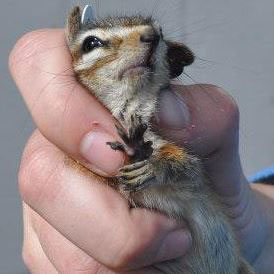 natal area, and predicts a mechanism that facilitates selection of suitable habitat for settlement. NHPI has been studied in a variety of taxa including mice, squirrels, birds, and fish. It may be adaptive, as habitat that produces individuals old enough to disperse is most likely habitat of reasonable quality, thus individuals should use cues from the natal area to help reduce search time and increase fitness. I am addressing several questions that involve natal dispersal, juvenile habitat selection, individual personality, and decision-making rules using cliff chipmunks (Tamias dorsalis) as a model system.
natal area, and predicts a mechanism that facilitates selection of suitable habitat for settlement. NHPI has been studied in a variety of taxa including mice, squirrels, birds, and fish. It may be adaptive, as habitat that produces individuals old enough to disperse is most likely habitat of reasonable quality, thus individuals should use cues from the natal area to help reduce search time and increase fitness. I am addressing several questions that involve natal dispersal, juvenile habitat selection, individual personality, and decision-making rules using cliff chipmunks (Tamias dorsalis) as a model system. -
Research Questions: Can an animal’s personality explain the search method (T, BN, or CB) used for selecting a new habitat? Does an animal’s personality affect natal dispersal distance? Do dispersing juveniles settle in habitat similar to their natal habitat (NHPI)?
Project Details (click to expand/reduce)
Differential Response of a Native Arizona Gray Squirrel and an Introduced Abert’s Squirrel to a Mosaic of Burn Severities
-
Time Period: August 2011-Present
-
Student: Shari Ketcham
-
Location: Santa Catalina Mountains, AZ, U.S.A.
-
 Major Questions: What burn severities do tree squirrels use post fire regarding resources such as dreys, cavities, and food? How large are the patch sizes of the burn severities that tree squirrels choose to use? Are there any competition factors between tree squirrels for resources post fire? If so, what resources do tree squirrels compete for? What is the estimated abundance and distribution of tree squirrels on the Santa Catalina Mountains?
Major Questions: What burn severities do tree squirrels use post fire regarding resources such as dreys, cavities, and food? How large are the patch sizes of the burn severities that tree squirrels choose to use? Are there any competition factors between tree squirrels for resources post fire? If so, what resources do tree squirrels compete for? What is the estimated abundance and distribution of tree squirrels on the Santa Catalina Mountains?

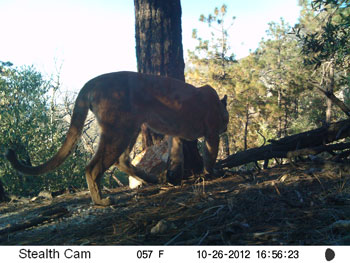
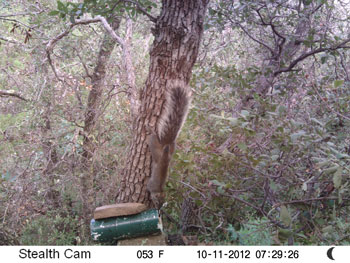
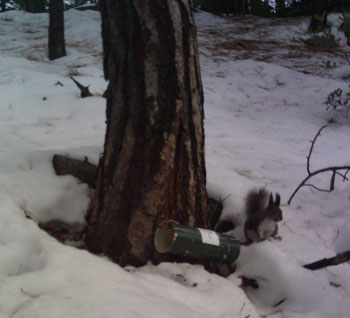
-
Major Findings: NA-Research in Progress
Project Details (click to expand/reduce)
Developing an ex situ propagation strategy of Mount Graham red squirrels (Tamiasciurus fremonti grahamensis) to positively affect their chances of survival after release into the wild
-
Time Period:Fall 2016 -Present
-
PHD student: Stuart Wells
-
Location: The Phoenix Zoo and Pinaleño Mountains AZ, U.S.A.
-
 Project Description & Bio:
Project Description & Bio: -
I have always been drawn to science, in particular to science-based questions such as how and why. I am particularly interested in applying information gained from scientific exploration directly towards understanding how species function in ecological systems and developing or improving how we manage animals within those systems. The field of conservation biology lends itself to these direct inquiries of how and why especially towards understanding how to manage ex situ animals destined for reintroduction. Effective species conservation is of crucial importance because the anthropogenic activities prevalent in the world today negatively impact nearly every aspect of the natural world. The effect of these activities on species abundance and biodiversity is either direct as a result of harvesting or exploitation, such as over-hunting and illegal trade of animals, or indirect as a result of environmental and ecological changes, such as climate change and watershed manipulation. These intrusions ultimately cause species declines, and can lead to local extirpation, or without managed intervention, species extinction. Consequently, developing an understanding of how to manage animals ex situ to maximize the likelihood of their survival when introduced into the wild is a promising tool for enhancing species conservation programs. The pilot propagation and release program for Mt. Graham red squirrel (Tamiasciurus fremonti grahamensis) is an example of one such effort. This subspecies was listed as critically endangered in 1987, due to drastic population decline caused by forest wildfire and subsequent disease that severely impacted its habitat and resource availability. Although studied extensively in the wild, the Mt. Graham red squirrel has yet to reproduce in an ex situ setting, placing importance on developing an efficient propagation and release program, coupled with an active habitat improvement program, as an essential component of the conservation of this species.
-
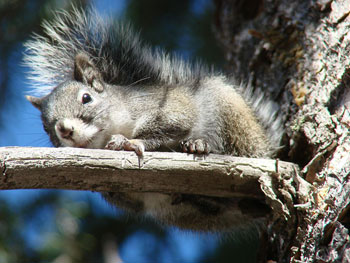
-
Due to the imperiled nature of T. f. grahamensis, the future survival of this species may rely on augmentation of ex situ propagated individuals to replenish the wild population. Much is known about the habitat preferences, foraging requirements, and social structure of Mount Graham red squirrels in the wild (Brown 1984, Sanderson 2009, Steele 1998.) Both sexes are solitary and have are extremely territorial (Sanderson and Koprowski 2009.) They are larder hoarders and maintain a “midden” that also serves to demarcate their territory (Sanderson and Koprowski 2009.) Intense territorial aggression is relaxed during the breeding season when males seek out receptive females to breed. It is believed that the female estrus cycles occur only one per breeding season (Steele 1998), and female receptivity is thought only to occur within a four or six-hour window (USFWS 2015.) Although the Mount Graham red squirrels have been held ex situ successfully (Wells, 2012), ex situ reproduction has not yet occurred. My research will use known hormone markers to ascertain and validate physiological patterns indicative of estrus, and by examining the associated male to female behavioral responses. Behavior-physiological information will then be used to develop management techniques to determine when to introduce pairs for breeding while minimizing the likelihood of injury, or estrus disruption due to aggression. Finally, I will also investigate optimal methods for ex situ rearing to maximize survival of individual squirrel translocated to in situ by attempting to create ex situ rearing conditions indicative of ideal habitat, or by mimicking natal dispersal cues (Merrick and Koprowski, 2016.)
Project Details (click to expand/reduce)
If you build it will they come? Artificial midden creation and settlement by Mt. Graham red squirrels
Time Period: January 2017 - May 2019
-
PhD student:Marina Morandini
-
Location: Pinaleño Mountains, Arizona, U.S.A.
-
Project Description & Bio:
-
 I am interested in which factors can regulate or limit population abundance. No population increases without limit, but understanding the factors that prevent this phenomenon is not easy. There are intrinsic and extrinsic factors that influence population size. Extrinsic factors influence populations by actions of other species, such as predators or competitors, and by physical-chemical factors such as climate or nutrient supplies. Intrinsic factors instead are internal to the population, such as sex, age, behavior and genetic traits. Understanding which factors could affect population dynamics of a particular animal or plant is the core of conservation, land management, fisheries and pest control and are crucial to developing specific management plans for individual species.
I am interested in which factors can regulate or limit population abundance. No population increases without limit, but understanding the factors that prevent this phenomenon is not easy. There are intrinsic and extrinsic factors that influence population size. Extrinsic factors influence populations by actions of other species, such as predators or competitors, and by physical-chemical factors such as climate or nutrient supplies. Intrinsic factors instead are internal to the population, such as sex, age, behavior and genetic traits. Understanding which factors could affect population dynamics of a particular animal or plant is the core of conservation, land management, fisheries and pest control and are crucial to developing specific management plans for individual species.
-
Research questions:
Despite more than fifteen years of legal protection, Mt Graham Red Squirrel population plummeted after a peak of 562 squirrels in 1999 to approximately 250 individuals in the recent years. Why is the population abundance not increasing? Are food resources a limited factor for this population? Can artificial midden help the settlement of squirrels during dispersal? Is there a high predator pressure on the squirrel population on Mt. Graham? Is it possible that parasites play a role in the regulation of this population? -
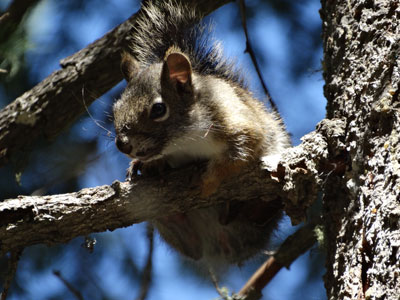
Personal background:
I completed my master’s degree in Italy where I studied the competition between the European Red Squirrel (Sciurus vulgaris) and the invasive species Pallas’s squirrels (Callosciurus erythraeus), whose native range is in southeast Asia. In particular I analyzed the competition for food and space, using telemetry and live-trapping.
I worked The University of Milan to control the invasive population of the Grey Squirrel near Milan.I volunteered for six months for Kluane Red Squirrel project (Yukon, Canada) where I worked to collect data on populations dynamics of red squirrel and snowshoe hare.
Project Details (click to expand/reduce)
Population and spatial ecology of the Pinaleño white-bellied vole, Microtus longicaudus leucophaeus
Time Period:Fall 2017 -Present
-
Master's student:Neil Dutt
-
Location: Pinaleño Mountains, Arizona, U.S.A.
-
Project Description & Bio:
-
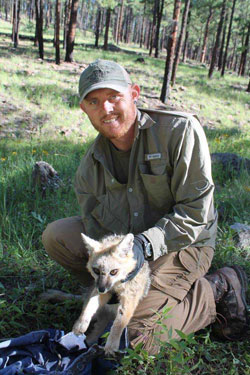 Populations that exist on the periphery of the species’ are living on the extreme limits of that species’ habitat tolerances relative to the core population. Studying the populations on the periphery of their range can provide insight into how that species, as a whole, may react in the face of climate change.
Populations that exist on the periphery of the species’ are living on the extreme limits of that species’ habitat tolerances relative to the core population. Studying the populations on the periphery of their range can provide insight into how that species, as a whole, may react in the face of climate change.
Long-tailed voles (Microtus longicaudus) are an abundant and wide ranging species of rodents in North America. This species ranges from Alaska to the sky islands of New Mexico and Arizona. These voles have been lightly studied in the northern part of their range in Alaska, Canada, and the Pacific Northwest, however, there are few studies on long-tailed voles in the southern extent of their range. The white-bellied vole (M. l. leucophaeus), a sub-species of the long-tailed vole, is endemic to the Pinaleño Mountains in southwestern Arizona. This population represents the southernmost extension of this species. The location and isolation of this population presents an exciting opportunity to learn more about how northern species may react to the changes brought about by climate change.Research questions:
In this study I aim to evaluate differences in the demography, social characteristics, and habitat selection of the isolated fringe population of long tailed voles, in the Pinaleño Mountains, in comparison to the northern core population.
Watch a video of a white-bellied vole
Project Details (click to expand/reduce)
Can red squirrel middens influence species diversity?
-
Time Period: August 2010-Present
-
Student: Erin Posthumus
-
Location: Mt. Graham, AZ, U.S.A.
-
 Red squirrels create structures, called middens, that concentrate food resources and create structural complexity in the forest, and some studies have found certain wildlife species to be associated with these middens. What is unclear is which characteristics of these middens attract species. My research will attempt to show which midden characteristics are most valuable to species diversity, which will have implications for forest management practices. My study will also shed light on the importance of larderhoarding animals to species diversity.
Red squirrels create structures, called middens, that concentrate food resources and create structural complexity in the forest, and some studies have found certain wildlife species to be associated with these middens. What is unclear is which characteristics of these middens attract species. My research will attempt to show which midden characteristics are most valuable to species diversity, which will have implications for forest management practices. My study will also shed light on the importance of larderhoarding animals to species diversity. -
Major Questions: Does species diversity differ at occupied middens, unoccupied middens and random locations? What characteristics of middens (i.e. vegetation features, food resources, and midden structure) affect species diversity? What is the importance of midden microclimate in explaining diversity?
-
Major Findings: Research in Progress
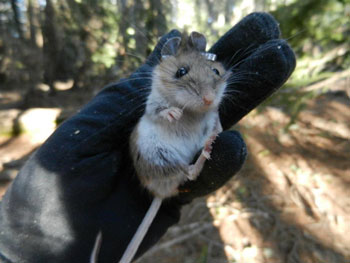
Project Details (click to expand/reduce)
Competition between native and introduced species
-
Time period: August 2010 – present
-
Student: Jonathan J. Derbridge
-
Location: Pinaleño Mountains, Arizona, USA
-
 Major Questions: I am studying mechanisms of competition between native and introduced species. Exploitation competition occurs when individuals have indirect negative effects on other individuals by restricting access to a common resource. Competition from introduced species for common food resources may force native species to forage more widely, and consume sub-optimal diets. Isolated populations of territorial species may, over time, become less adept at excluding ecologically similar competitors. I am using experimental removals of introduced Abert’s squirrels (Sciurus aberti) to test hypotheses on the impacts of dietary and spatial overlap with the Mount Graham red squirrel (Tamiasciurus hudsonicus grahamensis). I am also conducting tests of exploitation competition that relate to the relative abilities of an invader to succeed, and a native species to maintain its advantage. These tests include examining how Abert’s squirrels may take advantage of larder-hoarding by red squirrels, and comparing territorial behavior of Mount Graham red squirrels with individuals in other red squirrel populations.
Major Questions: I am studying mechanisms of competition between native and introduced species. Exploitation competition occurs when individuals have indirect negative effects on other individuals by restricting access to a common resource. Competition from introduced species for common food resources may force native species to forage more widely, and consume sub-optimal diets. Isolated populations of territorial species may, over time, become less adept at excluding ecologically similar competitors. I am using experimental removals of introduced Abert’s squirrels (Sciurus aberti) to test hypotheses on the impacts of dietary and spatial overlap with the Mount Graham red squirrel (Tamiasciurus hudsonicus grahamensis). I am also conducting tests of exploitation competition that relate to the relative abilities of an invader to succeed, and a native species to maintain its advantage. These tests include examining how Abert’s squirrels may take advantage of larder-hoarding by red squirrels, and comparing territorial behavior of Mount Graham red squirrels with individuals in other red squirrel populations. 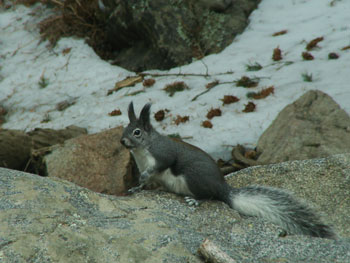
-
Research Questions: What are the impacts of dietary overlap between native and introduced species occupying similar niches? Does syntopy with an introduced species incur fitness costs associated with changes in home range size and composition for native species? Do introduced non-hoarding species compete with larder-hoarding native species through kleptoparasitism? Does isolation from interspecific competition lead to weakening of territorial behavior and facilitate successful invasions?
Project Details (click to expand/reduce)
Proximate cues and ultimate consequences for natal dispersal and settlement in an altered forest landscape: influence of experience, behavior, and habitat
-
Time Period: May 2010 - Present
-
Student: Melissa Merrick
-
Location: The Pinaleño Mountains, AZ, U.S.A.
-
 Major Questions: I am interested in factors influencing animal movements and habitat selection in the face of landscape alteration and fragmentation. Movement via natal dispersal is an important ecological mechanism contributing to gene flow, population structure and population dynamics, and guards populations against local extinction. Natal dispersal includes three stages: emigration, transience and exploration, and immigration and settlement. Whether an individual disperses, if it disperses how far it travels, how many places it explores, and where it settles is highly variable and is conditioned upon many factors including individual condition, local population density, sex ratios, resource abundance, experience in the natal area, habitat fragmentation, and individual behavior differences. Previous studies have shown that experience in the natal area provides individuals with important habitat cues which aid in deciding upon where to settle and also leads to variation in settlement patterns. Individual behavior differences may play a role in
Major Questions: I am interested in factors influencing animal movements and habitat selection in the face of landscape alteration and fragmentation. Movement via natal dispersal is an important ecological mechanism contributing to gene flow, population structure and population dynamics, and guards populations against local extinction. Natal dispersal includes three stages: emigration, transience and exploration, and immigration and settlement. Whether an individual disperses, if it disperses how far it travels, how many places it explores, and where it settles is highly variable and is conditioned upon many factors including individual condition, local population density, sex ratios, resource abundance, experience in the natal area, habitat fragmentation, and individual behavior differences. Previous studies have shown that experience in the natal area provides individuals with important habitat cues which aid in deciding upon where to settle and also leads to variation in settlement patterns. Individual behavior differences may play a role in dispersal distance and settlement decisions, including decision rules individuals employ when selecting a place to settle. Local density of conspecifics and associated sex ratios may influence male settlement decisions, whereas female settlement decisions may be more driven by available food resources. Increasingly, habitat fragmentation is also becoming an external factor influencing dispersal decisions and evidence suggests that small mammals dispersing through a fragmented habitat matrix tend to disperse further and explore less than individuals in contiguous habitat. I am testing several hypotheses related to natal habitat preference induction, behavioral phenotypes, decision rules, and habitat fragmentation and their influence on natal dispersal, especially transience and immigration.
dispersal distance and settlement decisions, including decision rules individuals employ when selecting a place to settle. Local density of conspecifics and associated sex ratios may influence male settlement decisions, whereas female settlement decisions may be more driven by available food resources. Increasingly, habitat fragmentation is also becoming an external factor influencing dispersal decisions and evidence suggests that small mammals dispersing through a fragmented habitat matrix tend to disperse further and explore less than individuals in contiguous habitat. I am testing several hypotheses related to natal habitat preference induction, behavioral phenotypes, decision rules, and habitat fragmentation and their influence on natal dispersal, especially transience and immigration. -
Some of my main research questions include: Do natal habitat cues (e.g. habitat structure, associated microclimate, and food availability) influence where settlement occurs? Do individual behavior differences (behavioral phenotypes) influence exploratory movements, decision rules, dispersal distance, and survival? Does forest fragmentation influence decision rules, settlement choices, and survivorship?
-
Major Findings To Date: Compared to non-peripheral red squirrel populations, dispersal in MGRS is sex-biased and exploration movements and settlement distances are far greater. Individual behavior differences explain variation in dispersal distances - active, aggressive individuals tend to disperse longer distances compared to less active, docile individuals. Natal habitat structure may play a role in cueing dispersers in on locations in which to settle. Forest structure derived from remotely sensed LiDAR data (e.g. canopy cover, basal area of live trees) in an individual’s natal area is more similar to forest structure at an individual’s settlement location compared to random locations. Further analyses are underway.

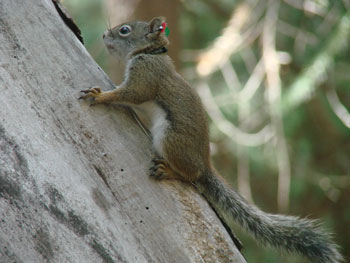
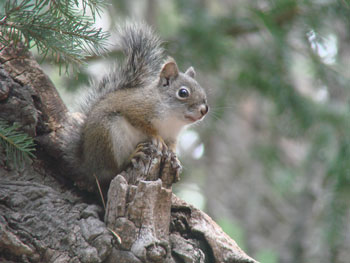
Project Details (click to expand/reduce)
Road and traffic effects on movements and space use of red squirrels
-
Time Period: 2009 - present
-
Student: Hsiang Ling Chen
-
Location: Mt. Graham, AZ, U.S.A.
-
 Road ecology is a burgeoning field of inquiry as roadways expand in number, length and width. We know that roads fragment habitats, increase mortality, change microclimates, and can act as barriers…thus they present a challenge in the conservation of biodiversity. Roads may function as impermeable barriers to some species while being semi-permeable to others. We are examining the relative permeability of roads to two species in the Pinaleno Mountains of southeastern Arizona: federally endangered Mt. Graham red squirrels (Tamiasciurus hudsonicus grahamensis) and non-native Aberts squirrels (Sciurus aberti).
Road ecology is a burgeoning field of inquiry as roadways expand in number, length and width. We know that roads fragment habitats, increase mortality, change microclimates, and can act as barriers…thus they present a challenge in the conservation of biodiversity. Roads may function as impermeable barriers to some species while being semi-permeable to others. We are examining the relative permeability of roads to two species in the Pinaleno Mountains of southeastern Arizona: federally endangered Mt. Graham red squirrels (Tamiasciurus hudsonicus grahamensis) and non-native Aberts squirrels (Sciurus aberti). -
Major Questions: Do red squirrels avoid roads? If so, what factors are most influential to avoidance? Do they avoid forest edges created by roads, forest gaps, or traffic disturbances?
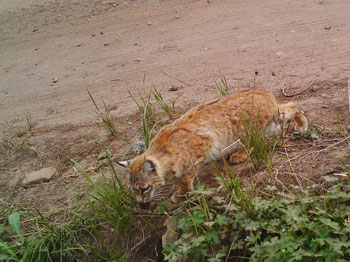
Project Details (click to expand/reduce)
Mammal detection and identification using non-invasive method: hairtube sampling
-
Time Period: 2009 - present
-
Student: Timothy G. Jessen
-
Location: Pinaleño (Graham) Mountains, Graham County, southeastern Arizona (Coronado National Forest).
-
Major Questions/Objectives: Oftentimes ecological questions require information about what species occur within an area, where these species occur, and assessments of biodiversity. But species can provide challenges to sampling. Among small mammals, small size, inconspicuousness, and cryptic behavior lend to relative difficulty in sampling these species. Small mammals; however, are suffering increased rates of extinction and due to their intimate relationship with microhabitats, are thought to be significantly impacted by climate change, anthropogenic activity, and other environmental perturbations. Therefore accurate and reliable sampling techniques are paramount.
-
A relatively novel method, known as hairtube sampling, offers great promise in sampling mammal (i.e. small mammal) species. Hairtube sampling is a non-invasive method for collecting mammal hair. Collected hair, when viewed under a microscope, has distinct features, thus permitting identification of unique species. Qualities of hairtube sampling include its non-invasive nature, extended sampling periods and larger sampling areas, potential to sample multiple species, and cost effectiveness. However, validation of the method is lacking. My research aims to rigorously test hairtube sampling and assess efficacy and utility of the method. My research will also produce a key for identifying mammal hair; providing a resource for future studies : How well do hairtubes detect species when presence is known? -Are hairtubes able to detect multiple species? -What are strengths/limitations of hairtube sampling, and what is best application(s) of the method?
-
Major Findings: Research still in progress; however, initial findings suggest hairtubes offer high probability of detecting species and ability to sample multiple species. Thus far, we have sampled and positively identified 10 species of mammals; ranging in size from cliff chipmunk (Tamias dorsalis) to black bear (Ursus americanus).
Project Details (click to expand/reduce)
Competition for conifer cones as a potential mechanism of endangerment for the Mt. Graham red squirrel.
-
Time Period: 2007 - 2010
-
Student: Rebecca Minor
-
Location: Pinaleño (Graham) Mountains, Graham County, southeastern Arizona (Coronado National Forest).
-
Major Questions/Objectives: Non-native species are a major cause of endangerment for native species, but the mechanisms are often unclear. The sky island region of the southwestern US and northwestern Mexico supports many isolated endemic species that are restricted to high elevation forests and vulnerable to species invasions. One such range, the Pinaleño Mountains in southeastern Arizona, supports the entire population of the critically endangered Mount Graham red squirrel (Tamiasciurus hudsonicus grahamensis) (MGRS). A second tree species, the Abert’s squirrel (Sciurus aberti) was introduced to the range in 1941 by Arizona Game and Fish Department for increased recreational hunting opportunities. Our field experiment quantified the impact of introduced Abert's squirrels on rates of food removal within the range of the MGRS. We placed single cones on 4m x 4m plots (1m spacing) at random locations in the forest and observed the rate of removal by both species of squirrel through direct observation and remote cameras. Then Abert’s squirrels were excluded from cone removal by placing cones in wire mesh tubes that were of small diameter, so that only MGRS could enter. burn severity? Does the landscape pattern (patchiness) of burn severity affect squirrel habitat use?
-
Major Findings: In the presence of Abert's squirrels, the time until 50% of cones were removed was significantly faster than when Abert's squirrels were excluded. The impact on food availability as a result of cone removal by Abert's squirrels suggests the potential of food competition as a mechanism of endangerment for the Mount Graham red squirrel. We suggest that a successful management approach for MGRS with target the impact of Abert’s squirrels on food availability. That a large proportion of cones available to both MGRS and Abert’s squirrels were removed before cones available only to MGRS suggests the importance of considering removal of the introduced Abert’s squirrel as a priority in conserving red squirrels in the Pinaleño Mountains.
Project Details (click to expand/reduce)
Factors influencing habitat use by wildlife relative to landscape disturbance
-
Time Period: August, 2006 – December, 2010
-
Student: Sandy Doumas
-
Location: The Chiricahua Mountains, AZ, U.S.A.
-
 Major Questions: I am interested in factors influencing habitat use by wildlife relative to landscape disturbance, especially fire. Fire is a necessary and recurring disturbance in many ecosystems with profound effects over time on vegetation composition, structure, and landscape pattern. The effects of fire on ecosystems have been complicated by decades of fire suppression followed by reintroduction of fire into fire-deprived ecosystems. Historically, fire-adapted forests were relatively resilient to fire, and some current forest management techniques seek to restore forests to historical composition, structure, and landscape pattern to recreate fire-resiliency. I study habitat use by native wildlife to better understand the response of wildlife to alterations of vegetation structure and pattern following the reintroduction of fire. Specifically, I study habitat use of the Mexican fox squirrel, Sciurus nayaritensis chiricahuae, in conifer forests of the Chiricahua Mountains of SE Arizona, which have experienced several recent fires.
Major Questions: I am interested in factors influencing habitat use by wildlife relative to landscape disturbance, especially fire. Fire is a necessary and recurring disturbance in many ecosystems with profound effects over time on vegetation composition, structure, and landscape pattern. The effects of fire on ecosystems have been complicated by decades of fire suppression followed by reintroduction of fire into fire-deprived ecosystems. Historically, fire-adapted forests were relatively resilient to fire, and some current forest management techniques seek to restore forests to historical composition, structure, and landscape pattern to recreate fire-resiliency. I study habitat use by native wildlife to better understand the response of wildlife to alterations of vegetation structure and pattern following the reintroduction of fire. Specifically, I study habitat use of the Mexican fox squirrel, Sciurus nayaritensis chiricahuae, in conifer forests of the Chiricahua Mountains of SE Arizona, which have experienced several recent fires. 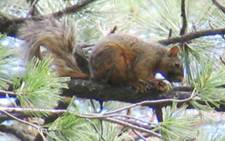
-
Some of my main research questions include: Does burn severity of recent fires and vegetation structure affect squirrel habitat use? How are the vegetation characteristics most important to habitat use related to burn severity? Does the landscape pattern (patchiness) of burn severity affect squirrel habitat use?
-
Major Findings: To Date: Mexican fox squirrels feed in forest with open understory and closed canopy cover. Vegetation within home ranges of squirrels is characterized by lower understory density, consistent with the effects of low-severity fire, and larger trees than random locations. These results suggest that return of low-severity fire can help restore habitat for Mexican fox squirrels and other native wildlife species with similar habitat affiliations in forests with a historical regime of frequent, low-severity fire. Habitat use by Mexican fox squirrels is positively associated with moderate burn heterogeneity, suggesting that small areas of severe burn incorporated within low-severity burn may be beneficial to Mexican fox squirrels and other native wildlife species.
Project Details (click to expand/reduce)
Response of the Mount Graham Red Squirrel (Tamiasciurus hudsonicus grahamensis) to Postfire Conditions
-
Time Period: 2006-2007 (field work) 2008-2012 (data analysis, writing, publication)
-
Student: Seafha Tuttle (Blount)
-
Location:Mt. Graham, AZ, U.S.A.
-
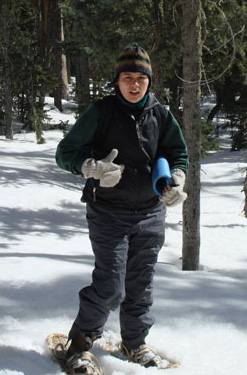 Major Questions/Objectives: Our main objectives were to assess space use of Mount Graham red squirrels, vegetation characteristics associated with middens, and continued occupancy of middens, mountain-wide, by Mount Graham red squirrels in areas of various burn severity.
Major Questions/Objectives: Our main objectives were to assess space use of Mount Graham red squirrels, vegetation characteristics associated with middens, and continued occupancy of middens, mountain-wide, by Mount Graham red squirrels in areas of various burn severity. -
Major Findings: A main effect of season on both size of home ranges and core areas was apparent. No main effect of burn severity on size of home range or size of core area was detected. Slope, canopy cover, burn severity, and aspect were important variables for distinguishing middens from random locations. Dead trees, aspect, and total number of trees were important for distinguishing between occupied and unoccupied middens. Mountainwide, occupancy of middens was influenced by burn severity of middens and surrounding vegetation. Also, unburned middens were occupied more continuously than burned middens.

-
Citation: Blount and Koprowski. 2012. Response of the Mount Graham red squirrel (Tamiasciurus hudsonicus grahamensis) to postfire conditions. The Southwestern Naturalist 57(1):8-15
Project Details (click to expand/reduce)
What can endemics tell us? Space use and ecology of the endemic Arizona gray squirrel
-
Time period: August 2006 – December 2009
-
Student: Nichole Cudworth
-
Location: Huachuca Mountains, Arizona, USA
-
Research questions: How does mating strategy influence the space use of Arizona gray squirrels? At what scale are Arizona gray squirrels selecting nest sites?
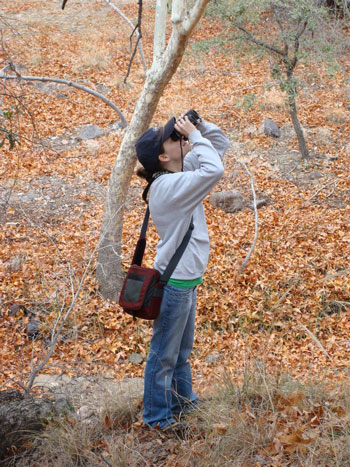
-
Major findings: Parental investment often differs between the sexes. For mammals, females invest heavily in reproduction, due to the high costs of pregnancy and lactation. Consequently, fitness of females is likely limited by the availability of food. Fitness of males, however, is more likely limited by the availability of mates. We investigated how these
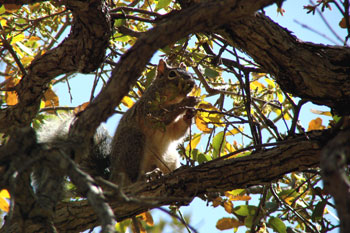 limiting factors would be predicted to influence the space use of Arizona gray squirrels. Arizona gray squirrels do not defend territories, and a female will only enter estrus for one day throughout the breeding season, thereby significantly reducing mating opportunities for males. We found that home ranges of Arizona gray squirrels are large (59 ha) and vary between sexes and seasons. Males had larger home ranges than females overall, and males increased home-range sizes during the breeding season, when males were traveling greater distances to locate receptive females. Females, however, maintained relatively constant home-range sizes throughout the year, although these home ranges were still large compared to other, closely related species, suggesting a system in which food availability is likely patchy and variable.
limiting factors would be predicted to influence the space use of Arizona gray squirrels. Arizona gray squirrels do not defend territories, and a female will only enter estrus for one day throughout the breeding season, thereby significantly reducing mating opportunities for males. We found that home ranges of Arizona gray squirrels are large (59 ha) and vary between sexes and seasons. Males had larger home ranges than females overall, and males increased home-range sizes during the breeding season, when males were traveling greater distances to locate receptive females. Females, however, maintained relatively constant home-range sizes throughout the year, although these home ranges were still large compared to other, closely related species, suggesting a system in which food availability is likely patchy and variable. -
Tree squirrels are highly dependent upon nests to provide a place to rest, raise young, avoid predators, and escape inclement weather. However, the scale at which nest-site selection has been analyzed has not been consistent, despite the obvious management implications when designing habitat plans. Arizona gray squirrels use leaf nests, or dreys, extensively throughout the year. We evaluated nest-site selection at 4 spatial scales: forest-type, nest-site, nest-tree, and within-canopy placement. Arizona gray squirrels select nesting locations within all spatial scales, although the benefits provided within these spatial scales likely varies, including providing access to food and water, cover from predators, travel routes to and from nest trees, thermal protection, and stable nesting structures. Riparian areas and the availability of Arizona sycamores (Platanus wrighti) for nest sites were especially important, emphasizing the need to protect these unique forest types in the mountains of the southwestern United States.
Project Details (click to expand/reduce)
Movements of Mesocarnivores in a Fragmented Desert Environment
-
Time Period: 2005 - 2008
-
Student: Margaret G. Rheude
-
Locations: Santa Catalina, Rincon, Santa Rita, Whetstone, Huachuca, Pinaleño, Chiricahua, Dos Cabezas, and Tucson mountain ranges in southeastern Arizona.
-
Major Questions/Objectives: Through a combination of trapping and mitochondrial DNA analysis, examined the distribution, genetic population structure, dispersal ability, and long-term genetic history of striped skunk (Mephitis mephitis) and hooded skunk (M. macroura) populations in the mountain ranges of southeastern Arizona. Such information can be used in conservation of species of concern, amelioration of human conflict with wildlife, and mapping disease spread.
-
 Major Findings: Striped skunk populations showed genetic structure by mountain range with unpredictable dispersal routes likely non-riparian in straight-line distances. This unpredictable dispersal pattern can make disease mapping or habitat preservation problematic. Striped skunks had a stable genetically diverse population, however, were found infrequently in urban environments (21% of all striped individuals) and had decreasing population trends in areas where they overlapped hooded skunks. Hooded skunks were common in urban areas (72% of all hooded skunks), with rapidly expanding newly established populations. Hooded skunks also appeared to disperse predominantly using riparian corridors over straight-line distances with populations strongly structured by river basin. Hooded skunks may outcompete striped skunks in urban areas, possibly due to better adaptation to xeric environments. Results indicate that a species' use of dispersal corridors is unpredictable; willingness to use established dispersal corridors may correspond to environmental conditions in which an animal adapted. However, wildlife corridors and wildlife habitat could serve both as a means for dispersal as well as permanent habitat. These results indicate similar species have may have different distribution and dispersal patterns, as well as different management implications.
Major Findings: Striped skunk populations showed genetic structure by mountain range with unpredictable dispersal routes likely non-riparian in straight-line distances. This unpredictable dispersal pattern can make disease mapping or habitat preservation problematic. Striped skunks had a stable genetically diverse population, however, were found infrequently in urban environments (21% of all striped individuals) and had decreasing population trends in areas where they overlapped hooded skunks. Hooded skunks were common in urban areas (72% of all hooded skunks), with rapidly expanding newly established populations. Hooded skunks also appeared to disperse predominantly using riparian corridors over straight-line distances with populations strongly structured by river basin. Hooded skunks may outcompete striped skunks in urban areas, possibly due to better adaptation to xeric environments. Results indicate that a species' use of dispersal corridors is unpredictable; willingness to use established dispersal corridors may correspond to environmental conditions in which an animal adapted. However, wildlife corridors and wildlife habitat could serve both as a means for dispersal as well as permanent habitat. These results indicate similar species have may have different distribution and dispersal patterns, as well as different management implications.
Project Details (click to expand/reduce)
Ecology of the endemic Mearns’s squirrel (Tamiasciurus mearnsi) in Baja California, Mexico
-
Time Period: August 2004 – May 2008
-
Students: Nicolas Ramos-Lara
-
Location: Sierra de San Pedro Mártir, Baja California, Mexico
-
 Major Questions: 1. What is the current situation of the arboreal squirrels of Mexico (review chapter)
2. Do Mearns’s squirrels have specific habitat requirements for nesting?
3. Do home-range dynamics and habitat use of Mearns’s squirrels differ from other congeners?
4. Do life-history and behavioral tactics of Mearns’s squirrels differ from other congeners?
Major Questions: 1. What is the current situation of the arboreal squirrels of Mexico (review chapter)
2. Do Mearns’s squirrels have specific habitat requirements for nesting?
3. Do home-range dynamics and habitat use of Mearns’s squirrels differ from other congeners?
4. Do life-history and behavioral tactics of Mearns’s squirrels differ from other congeners? -
Major Findings: 1. In Mexico, there are 14 recognized species of arboreal squirrels of which four are endemic, with the states of Chiapas and San Luis Potosi possessing the greatest diversity. 2. Presently, all species are listed under some category of risk by IUCN, seven by Mexico’s SEMARNAT, and only one by CITES. 3. Our literature survey yielded 37 publications revealing that a dearth of scientific information still exists on the arboreal squirrels of Mexico. 4. States with a greater diversity of arboreal squirrels also have higher annual wood productions, which may pose a serious threat to their persistence. 5. Mearns’s squirrels rely primarily on tree cavities for nests, with nest tree species, nest tree condition, nest tree size (DBH), canopy cover, and occurrence of white firs (Abies concolor) as important characteristics of the habitat for nesting. 6. Without larderhoards (middens), home-range dynamics of Mearns’s squirrels are similar to nonterritorial squirrels of the genus Sciurus, suggesting that middens played an important role in the evolution of territoriality in Tamiasciurus. 7. Using satellite imagery, I found that remote areas in the Sierra de San Pedro Mártir appear to have suitable habitat for the species. 8. Survival of adult Mearns’s squirrels was influenced by sex and body mass. 9. Mearns’s squirrels are heavier and apparently also larger than other congeners, possibly in part as an adaptation to feed on large pine cones (Pinus). 10. Interyear variation in weather and food supply strongly influenced fitness-related traits and behavior of Mearns’s squirrels.
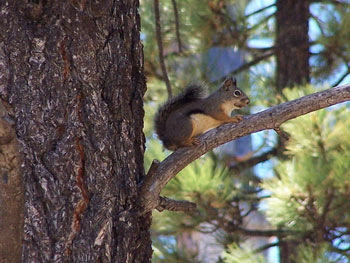
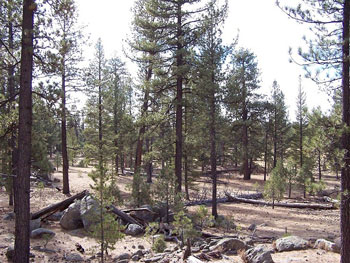

Project Details (click to expand/reduce)
Differential response to fire by an exotic and an endemic species complicate endangered species conservation
-
Time Period: May 2006 to Oct 2007
-
Student: Nate Gwinn
-
Location: Mount Graham (Pinaleño Mountains), Graham County, Arizona, USA
-
 Major Questions: The Nuttall Complex fire burned ~ 12029 ha in the Pinaleño Mountains of southeastern Arizona in summer 2004, including large areas of the upper elevation mixed conifer and spruce fir forests. Historically, mixed conifer forests in the Pinaleños experienced a low severity fire every 4 to 6 years, and spruce-fir forests experienced infrequent stand-replacement burns every 300 years. To investigate the effect of wildfire on exotic and introduced species, we looked at the differential use of burned and unburned areas by introduced Abert’s squirrels and the endemic and critically endangered Mount Graham red squirrel in the Pinaleños. We assessed effects of wildfire on habitat use of introduced Abert’s squirrels and native red squirrels by sampling species-specific feeding sign and employing radiotelemetry to reveal use of burned and unburned areas by both species. We document differential use of fire-impacted habitats that favors the introduced species thus complicating traditional conservation efforts used in forested environments.
Major Questions: The Nuttall Complex fire burned ~ 12029 ha in the Pinaleño Mountains of southeastern Arizona in summer 2004, including large areas of the upper elevation mixed conifer and spruce fir forests. Historically, mixed conifer forests in the Pinaleños experienced a low severity fire every 4 to 6 years, and spruce-fir forests experienced infrequent stand-replacement burns every 300 years. To investigate the effect of wildfire on exotic and introduced species, we looked at the differential use of burned and unburned areas by introduced Abert’s squirrels and the endemic and critically endangered Mount Graham red squirrel in the Pinaleños. We assessed effects of wildfire on habitat use of introduced Abert’s squirrels and native red squirrels by sampling species-specific feeding sign and employing radiotelemetry to reveal use of burned and unburned areas by both species. We document differential use of fire-impacted habitats that favors the introduced species thus complicating traditional conservation efforts used in forested environments. -
Major Findings: Our study is the first to document the positive response of an exotic mammal and negative response of the native species to wildfire and suggests that fire must be used judiciously as a restoration tool. Abert’s squirrels thrive in mixed conifer forest, our study documented that Abert’s squirrels fed, moved and nested within mixed conifer forest affected by wildfire. Home ranges of Abert’s squirrels were smaller in burned than in unburned forest. This suggests that habitat created by wildfire was of higher quality than unburned areas. Abert’s squirrels selected sites that had more live trees, less logs, and higher canopy closure than random sites within the burned area, similar to characteristics of mature ponderosa pine forests that Abert’s squirrels prefer in native range. These characteristics include high basal area, mature trees with interlocking crowns, and an understory with little down and woody debris. Transect data on feeding sign also indicated that Abert’s squirrels remained in burned areas. In effect, wildfire may be improving habitat for Abert’s squirrels in mixed conifer forest by creating preferred structure.
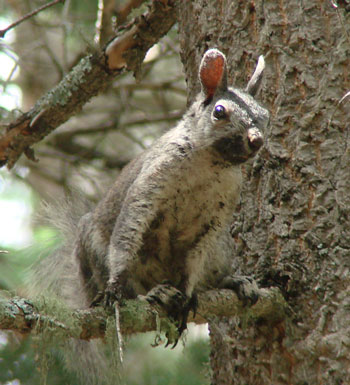
Project Details (click to expand/reduce)

Response of endangered Mt. Graham red squirrels to severe insect infestation
-
Time Period - August 2003 - April 2007
-
Student: Claire A. Zugmeyer
-
Location: The Pinaleño Mountains, AZ, U.S.A.
-
 Major Questions: Disturbance events create temporal and spatial heterogeneity of resources that can cause short- and long-term changes to habitat and disrupt interactions between individuals and resources. Severe disturbance may dramatically alter habitat structure, causing reduced reproductive success or site abandonment. Rates and impacts of natural disturbances are predicted to increase with current trends in climate change, thus highlighting the need to understand species' response to disturbance. My research examined the response of the endangered Mt. Graham red squirrel to severe insect infestation. The Mt. Graham red squirrel (Tamiasciurus hudsonicus grahamensis) occupies high elevation spruce-fir and mixed-conifer forests of the Pinaleño Mountains in southeastern Arizona. Recent recolonization of insect-damaged forest provided an opportunity to examine response of red squirrels to insect infestation. I examined habitat selection, home range, body mass, and demography of Mt. Graham red squirrels inhabiting insect-damaged forest and drew comparisons to squirrels living in relatively undamaged forest.
Major Questions: Disturbance events create temporal and spatial heterogeneity of resources that can cause short- and long-term changes to habitat and disrupt interactions between individuals and resources. Severe disturbance may dramatically alter habitat structure, causing reduced reproductive success or site abandonment. Rates and impacts of natural disturbances are predicted to increase with current trends in climate change, thus highlighting the need to understand species' response to disturbance. My research examined the response of the endangered Mt. Graham red squirrel to severe insect infestation. The Mt. Graham red squirrel (Tamiasciurus hudsonicus grahamensis) occupies high elevation spruce-fir and mixed-conifer forests of the Pinaleño Mountains in southeastern Arizona. Recent recolonization of insect-damaged forest provided an opportunity to examine response of red squirrels to insect infestation. I examined habitat selection, home range, body mass, and demography of Mt. Graham red squirrels inhabiting insect-damaged forest and drew comparisons to squirrels living in relatively undamaged forest. 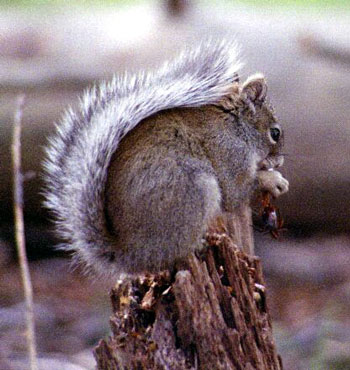
-
Major Findings: I examined habitat selection within insect-damaged forests by comparing physical and vegetative characteristics at 1) occupied middens, 2) a random subset of unoccupied historical middens, and 3) random locations. Mt. Graham red squirrels established middens in areas with <64% tree mortality. Greater basal area, canopy cover, and log volume best distinguished middens from random locations. Only greater basal area of live trees significantly distinguished occupied middens from unoccupied middens. Midden surface temperature depended on surrounding vegetation structure and tended to be cooler at occupied middens than unoccupied middens. These habitat components are congruent with features found at middens prior to the insect infestation as well as those found in other parts of the red squirrel distribution, indicating that red squirrels do not alter habitat selection after insect disturbance. I used radiotelemetric techniques and live-trapping to examine home range, body mass, and demographics of Mt. Graham red squirrels inhabiting insect-damaged and healthy forest. Squirrels living within insect-damaged forest had larger home ranges than squirrels within healthy forest. Females had larger home ranges than males in healthy forest, but I detected no difference between sexes in insect-damaged forest. Squirrel body mass, reproductive condition, and litter size did not differ between forest types, suggesting insect-damaged forest provided adequate resources. However, squirrels inhabiting insect-damaged forest experienced lower survivorship and 50% fewer potential reproductive events than squirrels in healthy forest. Although Mt. Graham red squirrels demonstrate equal-preference for habitat within insect-damaged forests and reproduce as well as individuals in healthy forest, poor survivorship and reduced potential to reproduce suggest insect-damaged forest may function as an ecological trap and has potential to threaten the persistence of this isolated population. Therefore, preservation of remaining healthy forest is a priority for management of this endangered species.
Project Details (click to expand/reduce)
Variation among red squirrel populations: Ecological differences at the edge of their range and response to fire.
-
Time Period: 2004 - 2006
-
Student: Katharine M. Leonard
-
Location: Pinaleño (Graham) Mountains, Graham County, southeastern Arizona (Coronado National Forest). White Mountains, Greenlee County, east-central Arizona (Apache-Sitgreaves National Forest).
-
Major Questions/Objectives: Populations at the edge of their geographic range may inhabit areas with different habitat structure and resources than central populations, and thus may differ in population dynamics. Understanding these unique characteristics is especially important for populations of high conservation priority, such as the endangered Mt. Graham red squirrel (Tamiasciurus hudsonicus grahamensis). The Mt. Graham red squirrel (MGRS) is endemic to southeastern Arizona, represents the southernmost red squirrel population and is found at lower densities than conspecifics in the center of the range. To determine if differences are due to conditions at the southern periphery of the range, we compared habitat characteristics, demography, body mass, space use and nesting behavior with another subspecies located at the southern edge of the range, the Mogollon red squirrel (T. h. mogollonensis). In addition, we studied demography and behavior of MGRS inhabiting areas within and outside areas of low-intensity burn following the Nuttall fire complex in the Pinaleño Mountains (summer 2004).
-
Major Findings: We found that mean and minimum daily temperatures were higher at Mt. Graham whereas maximum temperatures were higher in the White Mountains, male Mogollon red squirrels were heavier than male Mt. Graham red squirrels in all seasons and female Mogollon red squirrels were slightly heavier than female Mt. Graham red squirrels in spring, proportion of squirrels in reproductive condition was lower in female Mogollon red squirrels, Mogollon red squirrels had smaller home ranges, used different types of nests and traveled less distance to nest than Mt. Graham red squirrels. There were no differences in annual rainfall, seedfall, habitat characteristics or survival between mountain ranges. Localized conditions appear to account for the disparity between populations. These differences demonstrate the importance of evaluating attributes of peripheral populations for maximizing persistence and intraspecific diversity.
-
Upon examining MGRS physical and behavioral traits between areas of no burn and low-intensity burn from the 2004 Nuttall fire, we found that body mass, proportion of individuals in reproductive condition, and distance squirrels traveled to nest did not differ between squirrels within and outside the perimeter of the fire. Within the perimeter, red squirrels had smaller home ranges and shifted territories less frequently and had shorter distances from their previously held territories than squirrels outside the perimeter. Mount Graham red squirrels evolved with patchy, low-intensity fires like those that burned in mixed-conifer forests in the Pinaleño Mountains and may be able to persist in areas affected by this level of disturbance.
Project Details (click to expand/reduce)
Bat diversity, resource use and activity patterns along a Sonoran Desert riparian corridor
-
Time Period - 2002 – 2005
-
Student: Deborah J. C. Buecher
-
Location: Sabino Canyon Recreational Area, Santa Catalina Mountains, near Tucson, Arizona (Coronado National Forest).
-
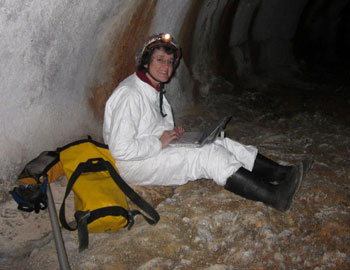 Major Questions: Riparian corridors in xeric environments act as contact zones between deciduous streamside and arid-adapted biotic communities, providing landscape complexity critical for wildlife. For bats foraging along riparian zones, this ecotone can supply food resources, day-roosts and access to drinking water. Yet, riverine areas are sensitive to anthropogenic alteration of habitat. The first goal of our research was to investigate the bat assemblage (using mist netting) at a wildland-urban interface associated with a Sonoran Desert riparian corridor, determine species richness, and assess differential spatial and temporal resource use.
The second goal of our research was to investigate how rugged canyons in the desert Southwest could be modeled to predict where food resources for insectivorous bats might be concentrated, as bats often anticipate productive feeding areas, given their spatial memory and knowledge of the landscape. This information could aid in better assessments of bat species diversity in canyon corridors.
Major Questions: Riparian corridors in xeric environments act as contact zones between deciduous streamside and arid-adapted biotic communities, providing landscape complexity critical for wildlife. For bats foraging along riparian zones, this ecotone can supply food resources, day-roosts and access to drinking water. Yet, riverine areas are sensitive to anthropogenic alteration of habitat. The first goal of our research was to investigate the bat assemblage (using mist netting) at a wildland-urban interface associated with a Sonoran Desert riparian corridor, determine species richness, and assess differential spatial and temporal resource use.
The second goal of our research was to investigate how rugged canyons in the desert Southwest could be modeled to predict where food resources for insectivorous bats might be concentrated, as bats often anticipate productive feeding areas, given their spatial memory and knowledge of the landscape. This information could aid in better assessments of bat species diversity in canyon corridors. 
-
Major Findings: Bat capture rate was high (17 species and 961 individuals) considering the aridity of the area. Seventeen species were documented, representing three bat families: Vespertilionidae, Molossidae and Phyllostomidae. We found that bats distribute themselves spatially along the canyon when water is plentiful, partitioning water resources where possible. When seasonal drying reduces water availability to isolated pools, numbers of species and individuals increase at remaining pools as bats compete for limited water. We also found distinct temporal variation in pool-use by the most frequently captured species. In addition, we proposed a hypothetical model, using a multidisciplinary approach to apply hydrologic models to evaluation of other 'fluids', such as cold-air drainage, in the canyons of the arid Southwest. Because small insects move through air much like swimming through molasses, they may be at the mercy of these airflow patterns. An understanding that insects are 'pooled' by the fluid nature of air may allow bats to anticipate foraging opportunities on patchy food resources and may enable bat ecologists to more accurately track bat diversity. The Sabino Canyon riparian corridor provides critical habitat for bats, however increased urbanization, associated groundwater extraction and recent forest fires, aggravated by regional drought, threaten this biologically diverse system. Riverine environments in arid landscapes are crucial for wildlife, both for foraging and as migratory corridors. Loss and degradation of riparian areas in arid regions put wildlife, particularly bats, at risk and preservation of this ecologically important resource should be a management priority.
-
Time Period: 2002 - 2006
-
Student: David Wood
-
Location: Pinaleño (Graham) Mountains, Graham County, southeastern Arizona. (Coronado National Forest), U.S.A.
-
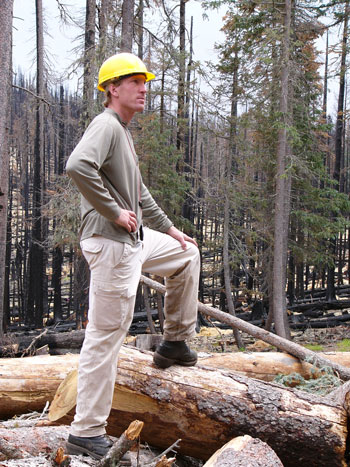 Major Questions: Difficulties in conservation and management of forest ecosystems arise from dynamics of forests and challenges in understanding disturbance. Disturbances, especially fire and insect outbreaks, have increased in occurrence and severity due to climate change and forest management.
Major Questions: Difficulties in conservation and management of forest ecosystems arise from dynamics of forests and challenges in understanding disturbance. Disturbances, especially fire and insect outbreaks, have increased in occurrence and severity due to climate change and forest management.
The Pinaleño Mountains of southeastern Arizona, USA have suffered catastrophic fire and large scale insect outbreaks in the last decade and are the only home of the federally endangered Mt. Graham red squirrel (MGRS: Tamiasciurus hudsonicus grahamensis), therefore an understanding the impacts of forest disturbances on population dynamics is critical for conservation of this fragile species. We sought to develop and a spatially explicit population model to predict long-term population dynamics of MGRS and to combine this model with life-history data and high-resolution satellite imagery with the goal of examining effects of future disturbances on the population. -
Major Findings: We tested model predictions using available range-wide red squirrel life-history data from the literature and fieldwork specific to the MGRS. An input data set using general mean life history values overpredicted MGRS abundance. However, we found significant correlation with known squirrel abundance using a general data set with curtailed fecundity and survival. A model with MGRS-specific data provided the best fit to observed population size. We investigated potential impacts of two major threats to the MGRS: competition from introduced Abert’s squirrels (Sciurus aberti) and increased levels of predation. Predation and particularly competition could have significant effects on the future population of the MGRS. Careful attention must be used to model the viability of fringe populations as peripheral populations can have a different life history than populations found in the range core. -
We also modeled potential Mt. Graham red squirrel habitat by identifying characteristics of cover surrounding their centrally defended larderhoards to assess effects of forest disturbance on habitat. We classified high spatial resolution satellite imagery into ground cover classes and used logistic regression to determine areas used by squirrels. We also used midden locations in conjunction with slope, elevation, and aspect variables to create a predictive habitat map for Mt. Graham red squirrels. Squirrels selected areas of denser forest with higher seedfall for midden sites. Among active middens, those in the densest and least damaged forests were occupied in more seasons than those in more fragmented and damaged areas. The future conservation of red squirrels and the return of healthy old-growth forests to the Pinaleño Mountains will rely on management in mixed conifer zones of the mountain and active restoration of highly damaged upper elevation spruce-fir forests to return them to squirrel habitat. This model allows us to evaluate the spectrum of fine- to coarse-scale disturbance effects (individual tree mortality to the area wide boundaries of a disturbance) with high-resolution satellite imagery. -
Lastly, we combined our spatially explicit population model with the spatial models of habitat heterogeneity. We parameterized the model with estimates of extent, frequency, and severity of insect outbreaks and fire and used the number of Mt. Graham red squirrel populations dropping below critical population thresholds to characterize the effects of these disturbances. We determined future disturbances, even at low levels, are likely to have a detrimental effect on Mt. Graham red squirrel population size. This model framework can be used to predict effects of future disturbance on habitat quality and population persistence for species in general.
-
Time Period: 2001 - 2004
-
Student: Bret S. Pasch
-
Location: Chiricahua National Monument (National Park Service), Chiricahua Mountains, southeast of Willcox, Cochise County, Arizona.
-
Major Questions/Objectives: Chiricahua fox squirrels (Sciurus nayaritensis chiricahuae) are endemic to the Chiricahua Mountains of southeastern Arizona. A paucity of natural history information and uncertain conservation status served as impetus for us to initiate a descriptive ecological study of the species. In addition, we examined the impacts of human suppression of fire on patterns of habitat use and survival of Chiricahua fox squirrels in fire-suppressed and fire-prescribed areas of the Chiricahua Mountains. We used radiotelemetry techniques to elucidate space and habitat use, survivorship, and fire impacts in our investigation.
-
Major Findings: We found that Chiricahua fox squirrels differed in several capacities from more widespread species of tree squirrels. Females had a mean of 1.6 (range 1-2) offspring per litter and we found an overall population density of 0.07/ha, both parameters lower than other North American tree squirrels. Seasonal fluctuations in body mass and space use generally paralleled other species of tree squirrels with some notable exceptions. Male Chiricahua fox squirrels maintained a fairly constant body mass and large home range size throughout the year, in contrast to other tree squirrel species that typically show a reduction in both measures in non-mating seasons. Extreme spatial and temporal fluctuations of food experienced by Chiricahua fox squirrels might result in annual patterns in space use and body mass that differ from tree squirrels living in forests with a greater abundance of food.
-
We found differences in habitat use and survival of squirrels in areas of the Chiricahua Mountains with differing fire regimes (suppressed vs. prescribed). Core areas of squirrels within fire-suppressed areas were larger and contained more understory shrubs than core areas of squirrels in fire-prescribed areas. Shrub cover and canopy heterogeneity influenced core-area size and distance traveled, and squirrels that were depredated traveled farther than conspecifics that survived, but shrub cover and canopy heterogeneity were not directly associated with squirrel survival. Suppression-induced increases in understory vegetation might force squirrels to travel greater distances to meet energetic requirements and thereby increase predation risk. Retention of mature forested canyons and restoration of natural fire regimes will be important for the persistence of Chiricahua fox squirrels.
-
Time Period: 2001 - 2004
-
Student: Andrew J. Edelman
-
Location: Pinaleño (Graham) Mountains, Graham County, southeastern Arizona (Coronado National Forest).
-
Major Questions/Objectives: Abert’s squirrels (Sciurus aberti) are reported to depend on ponderosa pine (Pinus ponderosa) for food and nest sites. Introduced Abert’s squirrels in the Pinaleño Mountains of Arizona, however, occupy mixed-conifer forests that contain almost no ponderosa pine (about 2%). We examined Abert’s squirrel nest site selection, diet, and home range in this novel habitat. In addition, we examined the potential for interspecific competition for nest sites and food resources between co-occurring native Mt. Graham red squirrels (Tamiasciurus hudsonicus grahamensis) and non-native Abert’s squirrels in the Pinaleño Mountains.
-
Major Findings: Abert’s squirrel dreys (i.e., spherical nests) were built adjacent to the trunk at 75% of the tree height. Dreys were found in 5 different conifer species and 2% were in ponderosa pine. Drey trees were larger and had more access routes than did random trees. The structural characteristics of drey trees in the Pinaleños population also were very similar to drey trees used by natural populations of Abert’s squirrels in ponderosa pine forests. Structural features such as tree size and access routes appear to be more important to selection of drey sites than tree species.
-
Through observations of marked animals, we found that individuals in the mixed-conifer forest ate similar food items as Abert’s squirrels in ponderosa pine forests, including seeds, inner bark, buds, and fungi, but 5 conifer species were used as food sources. Douglas-fir (Pseudotsuga menziesii) and southwestern white pine (Pinus strobiformis) were the most frequently eaten conifer species. Nests of Abert’s squirrels also were detected in all tree species. Our results for nest site selection and food suggest that the dependence of Abert’s squirrels on ponderosa pine is not as strong as previously reported.
-
Abert’s squirrel home-range size, home-range overlap with females, and movement distances increased for males from nonmating to mating seasons. Home-range size and overlap characteristics of females remained consistent between seasons, but movement distances were reduced during the mating season. Non-mating season home ranges in our study were smaller than home ranges observed in ponderosa pine forest. Abert’s squirrels in mixed-conifer forest may have small home ranges because resource quality is higher than in ponderosa pine forest or due to competition for space with co-occurring Mount Graham red squirrels.
-
Comparison of nest use between Mt. Graham red squirrels and Abert’s squirrels at different scales (nest, nest tree, and nest site) revealed contrasting results. Competition for nests and nest trees appears unlikely given the dissimilarity in use of nest types and tree characteristics. Abert’s squirrels predominately used dreys, whereas red squirrels mostly used cavity nests. Neither squirrel species occupied a nest used by the other species. Abert’s squirrel nest sites were found in a wider range of microhabitats including almost all microhabitats in which red squirrel nest sites were located. Although there was significant overlap, each species showed distinct trends in microhabitat. In general, red squirrel nest sites were characterized as more densely forested areas dominated by corkbark fir (Abies lasiocarpa var. arizonica), whereas Abert’s squirrel nest sites were more open and contained greater tree species diversity. Overlap in microhabitat characteristics increases the likelihood of interspecific competition and could increase the vulnerability of red squirrels to extinction.
-
We also used remote photography to assess the frequency of inter- and intra-specific kleptoparasitism and species richness at Mt. Graham red squirrel middens. Remote cameras and conifer cones were placed at occupied and unoccupied middens, and random sites. Species richness of small mammals was higher at red squirrel middens than random sites. Abert’s squirrels, potential kleptoparasites, were recorded only at unoccupied middens and random sites. Non-resident red squirrels were most common at unoccupied middens and rare at occupied middens and random sites. Inter- and intra-specific kleptoparasitism of red squirrel middens appears uncommon likely due to territorial behavior.